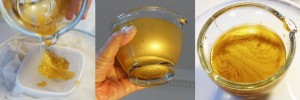Heat-Induced Colours on Metals
One of the most magical things about metals in general is their ability to transmit a wide range of colours under different conditions. The most brilliant and enduring pigments of the pre-industrial painters’ palette come from oxides, acetates and carbonates of metal ores and minerals. And the metals themselves, either in pure or alloyed form, yield a stunning range of colours, particularly in response to heating.
When you purchase mild steel in sheet form, its potential to yield colour is already apparent. There are gradations from light and dark greys to subtle blue tones, and maybe a bit of reddish oxidation here and there. These colours are only a few microns deep on the surface – when you cut or grind the steel it immediately reveals a very shiny silvery surface, which gradually patinates to grey. But if you apply heat to the newly exposed shiny surface, you get a most wonderful spectrum of colours – like a rainbow, but in a darker register.
The colours are a surface response to specific temperatures to which the metal is subjected, and engineers use these colours as a guide to the different degrees of hardness achieved by heat-treating the steel. This is because structural changes are taking place within the fabric of the metal as well as on the surface in response to rising degrees of applied heat.

Harmonograph pendulums resting on the hearth after a day’s work creating colour with a blowtorch. The rod in the foreground has not yet been heated. I sectioned the pendulums into polished and unpolished stripes to create contrasts in texture.
My motivation for heating the steel is nothing like as sophisticated as that of an engineer toolmaker – I just love to watch the magical transformation take place before my eyes, and to try to manipulate the colours as an aesthetic exercise.
As you train the concentrated flame of the torch onto the steel, it gradually turns a straw colour as it begins to reach a temperature of around 230 degrees Centigrade; as the temperature climbs towards 270 degrees it cycles though brown and then into purples, and finally, at about 300 degrees it gets to a beautiful indigo shade. The colours continue to cycle and flow along the piece of steel as the heat travels through it – it is actually very difficult to control. If you continue heating beyond 300 degrees you lose the colours altogether, and the steel hovers at grey for a while before it begins to glow through the reds and thence to the searing yellows (at over 1.000 degrees centigrade) which is forge-welding temperature.
Heat- colours continue to patinate, even after rapid cooling with water – they can darken, or they can gradually lose the colour, because it is actually a very delicate and microscopically thin surface layer of crystallized material that refracts light to create the impression of colour. During the pattern-welding workshop I undertook with Owen Bush, we experimented with heat on one of the billets we made – the layered magnesium-rich and nickel-rich steels showed slightly different rates of colouring, producing some beautiful patterns.
Some of the most spectacular responses to heating can be seen on brass, which is an alloy of principally copper and zinc. When Ricky Lee Brawn, engineer and metalwork technician at Central Saint Martins, heated up my brass plate to anneal it ready for hammer-forming, we got the spectacular and sadly ephemeral results in the picture below. Colours as delicate and elusive as the surface of a soap-bubble!





 "Making Masterpieces for a Prince of the Black Sheep" – my Bodleian Fellowship research blog
"Making Masterpieces for a Prince of the Black Sheep" – my Bodleian Fellowship research blog "The Book of Gold" – Gold pigment tutorial available from my Etsy shop
"The Book of Gold" – Gold pigment tutorial available from my Etsy shop
Hi Anita, I enjoyed your post. I worry about your inhaling zinc oxide as you heat up brass. Please lookup metal fume fever (MFF) which is an inhalation fever syndrome exhibited by welders of galvanized steel. Oxides of some of the additives of the more exotic steels can be worse. You will need a proper mask to be safe.
Cheers!
LikeLike
Hello Anita. You obviously know the subject of heat induced colour changes in metals. I chanced upon your article whilst researching a problem I’m currently facing. We make brass gas valves. Can you explain why the colour changes from bright golden to black when brass is forged. Is there some way to retain the golden shade? I can send you a spectro report if required. Please do revert. thank you. Beautiful work by the way. You can reach me at srini.sarathy@gmail.com. … Thank you.. Srini
LikeLike
These colours are so beautiful. I inherited a set of beautifully tuned wind chimes. Someone put them outside and they went black. Is it possible to return them to their former beauty?
LikeLike
The last photograph is exquisite, especially as it evokes the surface of a soap bubble.
LikeLike
Hi Melanie – I was thinking of you when I made that observation! Please add links to your site or one of your pictures in a reply to this, as I would love to share your work on my blog.
LikeLike